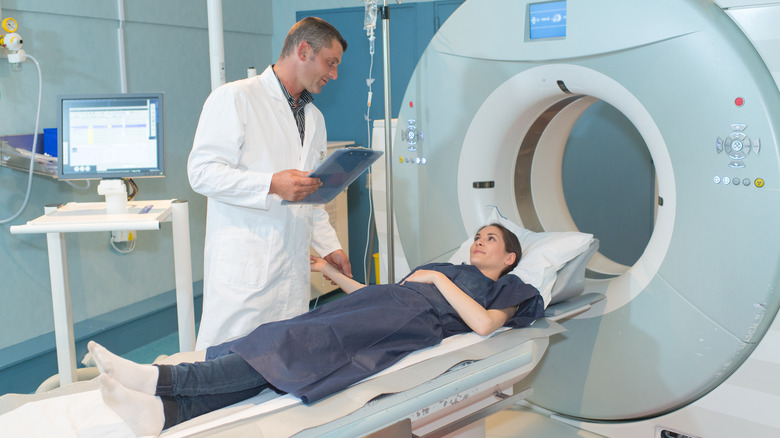Night Court Star Charles Robinson's Cause Of Death Explained
Veteran American actor Charlie Robinson, who is probably best known for playing court clerk Mac Robinson on the quirky and beloved sitcom "Night Court," died on July 11 at age 75 at Ronald Reagan UCLA Medical Center, according to The Hollywood Reporter.
Robinson's manager, Lisa Disante, confirmed his death to Entertainment Weekly, stating that the cause was "cardiac arrest with multisystem organ failures due to septic shock and metastatic adenocarcinoma." Robinson's wife, Dolorita Noonan-Robinson, released a statement describing Robinson as "the love of my life, husband, father, grandfather, and great-grandfather. He was truly the working actor's actor, and of all his passions, his craft took center stage, with his family being the wind beneath his wings, so he could soar to unbelievable heights! On behalf of my husband and family, I thank you for being a part of the audience."
Robinson enjoyed a diverse and long career on both stage and screen that extended over 50 years. According to Deadline, Robinson's big break came in 1983 when he was featured on the new sitcom "Buffalo Bill” starring Dabney Colman. The show earned several Emmy nominations, but was unable to garner a wide audience and was cancelled, freeing up Robinson to begin his nine-year tenure on "Night Court."
What is metastatic adenocarcinoma?
While Robinson's death was reportedly caused by a combination of factors, each of Robinson's health problems was serious enough on its own to be potentially life-threatening.
According to Everyday Health, metastatic adenocarcinoma is a type of cancer that forms in mucus-secreting gland cells found in the tissues that line your organs. When the adenocarcinoma spreads, it is then considered metastatic. Because metastatic adenocarcinoma can appear in different parts of the body, it is often difficult for doctors to determine the origin of the cancer, making it challenging to treat.
When doctors are able to determine where the metastatic adenocarcinoma first developed, the cancer can be classified based on its origin. For instance, metastatic pancreatic adenocarcinoma originates in the ducts of the pancreas. This type of advanced cancer is very hard to treat and, as a result, typically has only a five-year survival rate. According to Everyday Health, symptoms can include jaundice, weight loss, loss of appetite, and pain in the upper abdomen that spreads to the back. There is also metastatic adenocarcinoma of the lung, which most often develops in the smaller airways in the outer portion of the lung and occurs more frequently in women than men. Some common symptoms are constant coughing or coughing up blood, shortness of breath, trouble swallowing, and swelling in the face or veins in the neck, among others. Metastatic adenocarcinoma can also originate in other glandular areas of the body such as the esophagus, the colon, the breast and the prostate.
How is metastatic adenocarcinoma diagnosed?
Depending on the type of cancer, some symptoms of metastatic adenocarcinoma, such as diarrhea, fatigue, or even bleeding, may not initially cause you concern, so you should see a medical professional if these symptoms persist. WebMD explains that your doctor can investigate your organs during a physical exam to see if there is any swelling or if they feel a growth. Your doctor can also detect that something may not be right during a screening, such as when you have a colonoscopy.
Other tests that can help screen for metastatic adenocarcinoma in your organs include blood tests, which could reveal signs of anemia or evidence of a tumor, as well as imagining tests, such as CT scans and MRIs, which are powerful methods to get detailed pictures of the inside of your body. Getting a biopsy is also known to be an effective method. The doctor will remove a small amount of tissue in the area where they suspect you may have cancer, such as a polyp they remove from your colon or tissue from your breast. A pathologist will then look at the tissue under a microscope to see if there are any irregular cells. A biopsy can also help determine if the cancer is only in one organ, if it has spread to other areas of your body, or if the cells have grown.
How is metastatic adenocarcinoma treated?
According to WebMD, your treatment will depend on the kind of adenocarcinoma you have and what stage you are in. Once diagnosed, the likely first step will be to have surgery to remove the tumor and the tissue around it to see if you have clean margins or if the tissue also has cancer cells. Depending on the result, the surgery may not be enough. Then you would then need to pursue treatments such as chemotherapy, which can kill the cancer cells or slow the spread of the disease. An alternative method would be radiation, which uses X-rays and other types of rays that are known to be effective in killing cancer cells.
Unfortunately, these types of treatments will often kill your healthy cells at the same time they are treating the cancer cells. In addition, these treatments are known to have uncomfortable and unpleasant side effects, such as severe fatigue and nausea.
What is septic shock?
According to the Mayo Clinic, sepsis is a condition caused when the body's infection-fighting process works against the body, causing the organs to function in abnormal ways and damaging healthy tissue in the process.
Sepsis can sometimes lead to septic shock — a sharp drop in blood pressure that can lead to death — which is what reportedly happened to Robinson. As Robinson was already challenged by multiple serious health issues, chances are that preventing his septic shock proved too difficult. However, early treatment of septic shock with fluids and antibiotics is known to improve chances of survival.
One sign of septic shock is your body's need of medication in order to maintain your systolic blood pressure, which is the pressure your blood exerts against your artery walls when your heart beats. Another sign of septic shock, according to the Mayo Clinic, is the presence of high levels of lactic acid in your blood, indicating that your cells are not using oxygen properly. While most people who develop sepsis are already in the hospital — often in the intensive care unit where people are more likely to develop infections — any infection can lead to sepsis, so you should see a doctor if you have a wound that does not seem to be responding to treatment.
What is cardiac arrest?
According to Heart, cardiac arrest is the loss of heart function, and can occur whether or not you've been diagnosed with heart disease. Cardiac arrest can occur suddenly on its own, or as a result of other health issues — which is likely what happened in Robinson's case, given the combination and severity of his health issues. Not to be confused with a heart attack, which Heart describes as a circulation problem that leads to the "death of heart muscle tissue due to the loss of blood supply," a cardiac arrest is due to a malfunction of the heart's electrical system. The heart stops beating normally and becomes "arrested."
Cardiac arrest can lead to death, but, if caught early and swiftly treated, the circumstances can be reversed through CPR or the use of a defibrillator to shock the heart back into its normal rhythm. According to Medical News Today, while losing consciousness is often the first symptom for someone entering cardiac arrest, some people report symptoms such as dizziness, a racing heartbeat, chest pain, shortness of breath, or nausea prior to losing consciousness.
Anyone can get cardiac arrest, but it is possible to reduce your risk by adopting a nutritious diet, committing to a regular exercise regimen, refraining from smoking, and maintaining a healthy weight.






